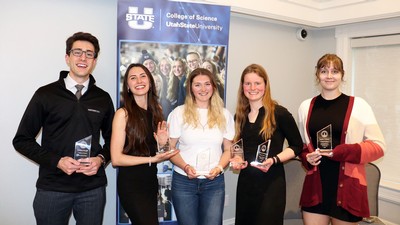Utah State Students Pedal to Victory in NASA's Great Moonbuggy Race
Utah State University engineering students designed and built a moonbuggy that captured victory at NASA's 12th Annual "Great Moonbuggy Race" in Hunstville, Ala., Saturday, April 9. A super light-weight aluminum design allowed the Aggie team to pedal to victory and earned a $3,500 check.
Utah State topped 28 other college and university teams from 14 states, Germany and Puerto Rico with a winning time of 3 minutes and 59 seconds. The team, comprised of undergraduate and graduate mechanical and aerospace engineering students, encountered some of the same challenges conquered by the original lunar rover team in the 1960s.
The students' moonbuggy challenge was to design a human-powered vehicle able to fit into a space of no more than four feet by four feet by four feet. The vehicle also must unfold quickly and be ready to ride, yet light enough for its two drivers to carry.
During the race, the two operators powered and drove the vehicle over a half-mile obstacle course of simulated moonscape terrain.
Graduate student Megan Mitchell and undergraduate David Huish manned the moonbuggy, and although the racers didn't haul soil and rock, they encounter many of the same design and engineering problems faced by the original rover team, NASA said. The Utah State team also made sure its moonbuggy could withstand the punishment of the rigorous course obstacles.
The team includes Mitchell and Huish as well as engineering students Skylar Cox, Tim Leech, Austin Hughes, Juan Stromsdorfer, Jon Walker and David Bartholomew.
This is the second year that Utah State has entered the competition, and students are excited about the possibilities the win brings. In 2004, the Utah State team received awards for "Best Engineering Design" from the American Institute of Aeronautics and Astronautics as well as "Most Unique Design." The unique design award was presented by Ronald Creel, an original member of NASA's Lunar Roving Vehicle program.
Comments and questions regarding this article may be directed to the contact person listed on this page.






